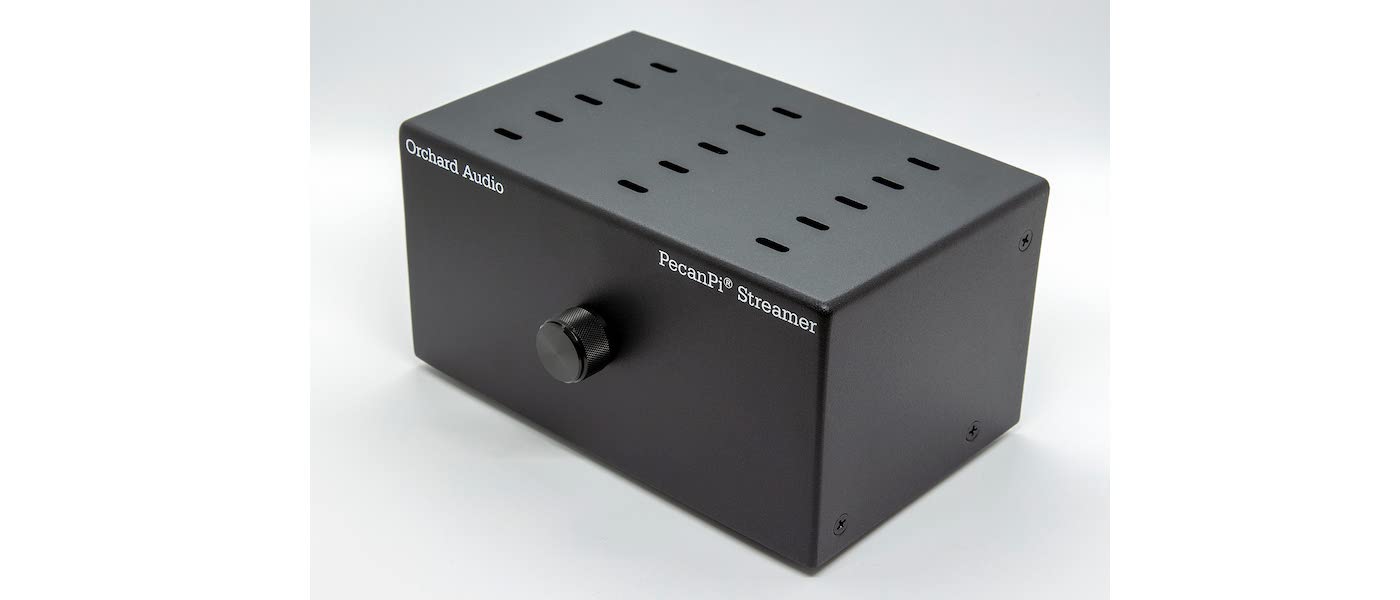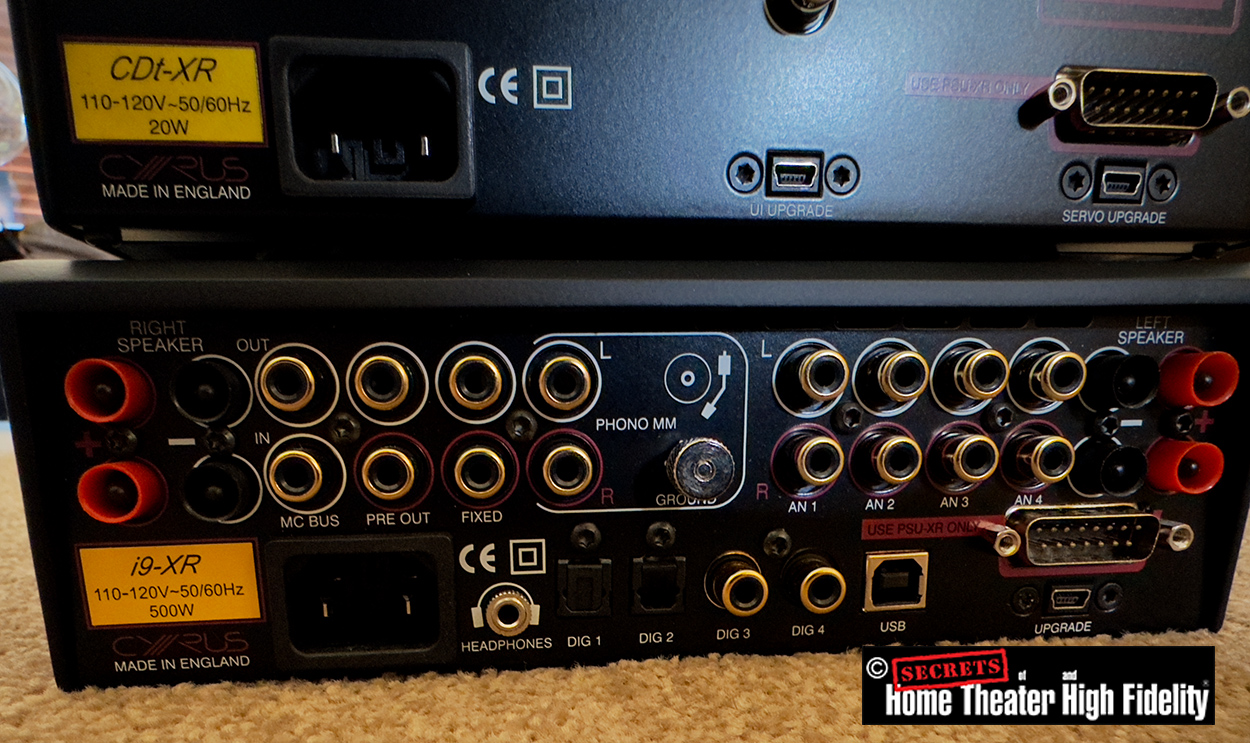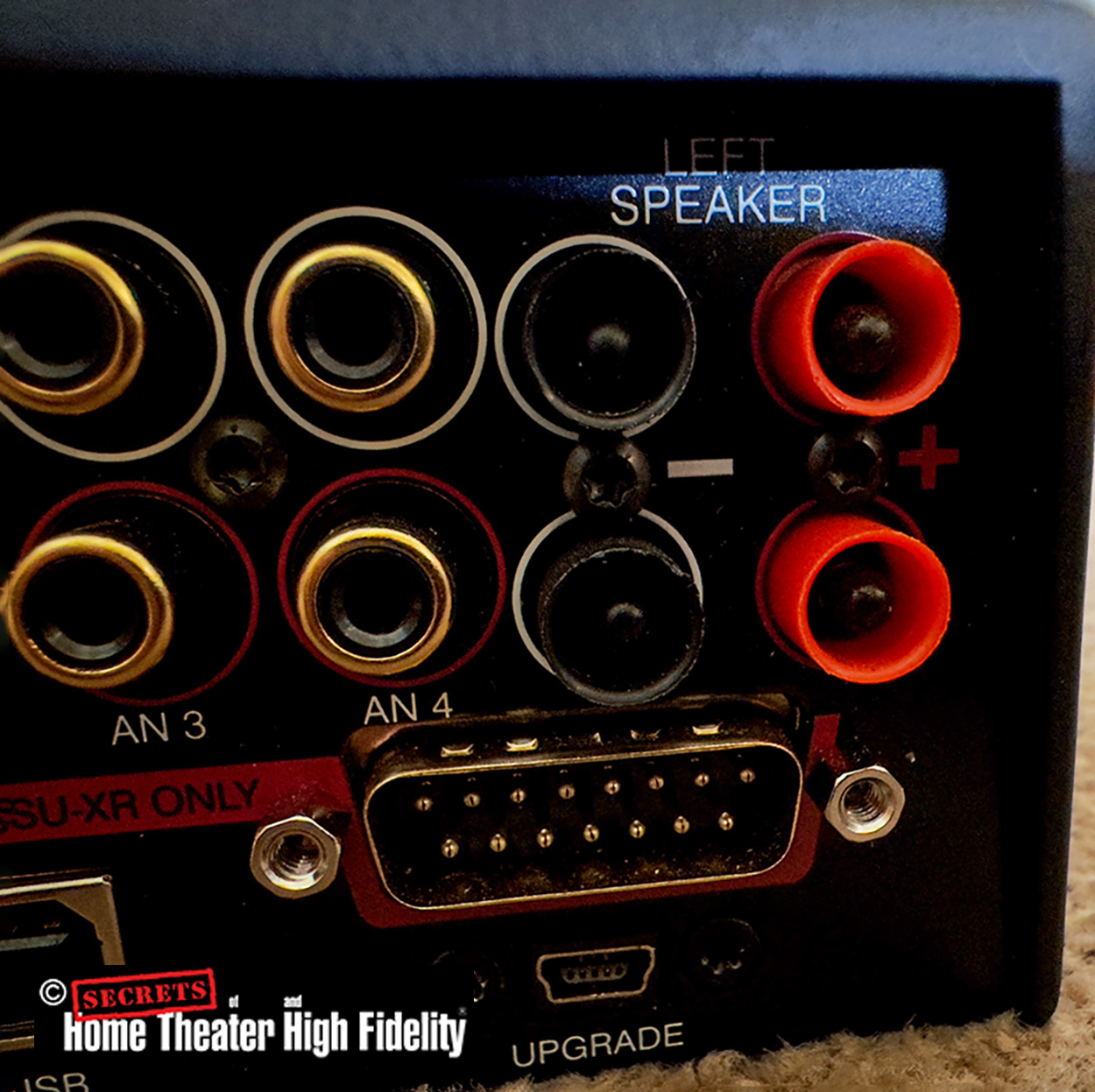The integrated amp and CD transport are designed to work together or separately. The power supply, the PSU-XR is designed to work with either the CD player, the CDt-XR, or with the integrated amplifier, the i9-XR.
I’m reviewing the integrated amp and the CD transport in separate reviews, then testing the 2 components together, adding the external power supply to see how they all work together and if the power supply improves the sound. So, consider this review as, Part 1.
Cyrus is a brand well-known in the U.K. and Europe. They were first noticed to some acclaim in 1984 with the Cyrus One amplifier. Since then, they have produced well-reviewed amplifiers and integrated amplifiers, CD players, power supplies, and more recently some speakers and headphones.
I lived in the U.K. during the 90s and when I visited HiFi stores Cyrus was quite the audiophile choice. I was able to audition Cyrus components back then and was always impressed.
I think the i9-XR Integrated Amplifier exemplifies the Cyrus heritage of careful, innovative engineering and always keeping in mind the joy of music listening.
The i9-XR can handle a wide variety of source components, both analog and digital, with digital inputs supporting USB audio to 384k sample rates, DSD256, SPDIF digital and optical inputs.
The i9-XR also has a port for the PSU-XR power supply, which I’ll review later.
On the analog side, we get 4 analog inputs, and a low noise phono input supporting MM cartridges. There is also a headphone port at the rear.
Like all Cyrus components, they look quite small from the front, about 8 1/2” wide, compared to the usual 17” wide components we generally see. The Cyrus components are quite deep though, around 14” deep, so they can’t be called small. Cyrus has just swapped dimensions to provide a smaller width.
Speaker Outputs:
2 x 91W into 6 Ω / twin
Inputs:
4 x Analog inputs
1 x Phono MM input
2 x Optical inputs
2 x Coaxial digital inputs
Inputs:
1 x Asynchronous USB
Outputs:
1 x Analog preamplifier out
1 x Headphone output – 2 x 138mW into 16 Ω (<0.1% THD)
Ports:
PSU-XR upgrade port
Dimensions (H x W x D):
73 x 215 x 360 mm (2.87” x 8.5” x 14.2”)
Weight:
6.5kg (14.33 lbs.)
MSRP:
$4499
Website:
SECRETS Tags:
Cyrus, i9-XR, amplifier, preamplifier, integrated amplifier, Cyrus reviews, Cyrus reviews 2023, amplifier reviews, amplifier reviews 2023
While the Cyrus may appear small from the front, it packs many advanced features. That includes the ability to bi-amp. It includes a fixed output should you want to hook up an analog tape deck or additional amplifier, and that output can also provide a signal for amplified speakers in another room.
The front panel has an array of buttons that are touch sensitive. These threw me originally because I kept pressing them expecting them to indent, but only a soft touch was needed. After powering the unit on, to save energy, standby will automatically begin 20 minutes after the music ends. If required, the auto-standby feature may be disabled in the setup menu.
There are of course controls for volume and balance. Headphone volume can be controlled separately on the front panel of the Cyrus or from the included remote. The last volume used comes on again when the Cyrus comes out of standby, which is a nice feature.
The Cyrus features something I don’t usually see on domestic components, and that is the addition of filters to adjust the output of the internal D/A converter. The company states that the best setting to use will depend on factors such as the sample rate of the recording and the technology used when the recording was made. For that reason, different filter settings may
be required to get the best results for different sources, recordings, and formats. The default setting provided is chosen for the best all-around performance. In my testing, I left the default filters in place.
These digital tweaks do not affect the analog inputs.
The Cyrus remote control can also work with other Cyrus components, so as we have in the case of this review, a single remote can control the integrated amp and the CD player. The remote has a backlight and can be programmed to learn the commands for other components, such as a TV or satellite receiver.
There’s a myriad of setup choices, that includes being able to name inputs, or selecting the volume offset for each input to get them at the same output level. There are also maximum output settings, useful with the headphone output and speakers, to prevent the audio from blasting and hurting your equipment or your hearing.
The display screen can also be set for brightness, color, and contrast.
Secrets Sponsor
The Cyrus came well-packed from its American distributor, Fidelity Imports, with the amplifier secured by two large foam end pieces. An included box contains instructions, a U.S. power cable, a remote with batteries, and a quick start guide that is quite complete.
The Cyrus i9-XR can take firmware updates, and they are available to download from the Cyrus website. They unit can be updated through its USB port and will require a PC or Mac.
This brings up the fact that the Cyrus has no wireless or wired internet connectivity, which I think in this day and age is nearly a must. Cyrus Audio advertises the Cyrus XR series as Roon Tested but not Roon Ready, which I deem a negative. You can plug the amplifier into a Roon Core and get music into it, but if the device had internet connectivity it would open the world of streaming and Roon. Of course, you can get that with an external device, and I used a Bluesound streamer during my testing, but it would have been nice to have it integrated.
The Cyrus comes with a multi-page quick setup guide. I’m not sure how ‘quick’ the setup is, as there are a lot of details to go through. There’s a complete manual available for download.
The first thing that will hit North American users is connecting speakers.
The i9-XR uses a European variant of the banana plug called a BFA model. That’s named for the British Federation of Audio. North American banana plugs can be easily inserted into European wall plugs which are round, not flat like ours. That’s a safety no-no, so Cyrus products shipped from their U.S. distributor come with BFA-style plugs. You’ll have to attach those connectors to bare cable yourself or buy new BFA-type cables if you want to use this amp over here. If you have banana plugs with hollow center pins they will work, but they aren’t the norm over here. It’s all a bit messy, and I’d be happy to see Cyrus ship amps for the U.S. market with the correct speaker connectors. Bare wire speaker connectors or spade lugs won’t work either. Cyrus does include BFA plugs with the i9-XR.
Secrets Sponsor
Here’s a photo of the plugs the Cyrus accepts. You can see the plug has a hollow space to accommodate the connector on the back of the amp.
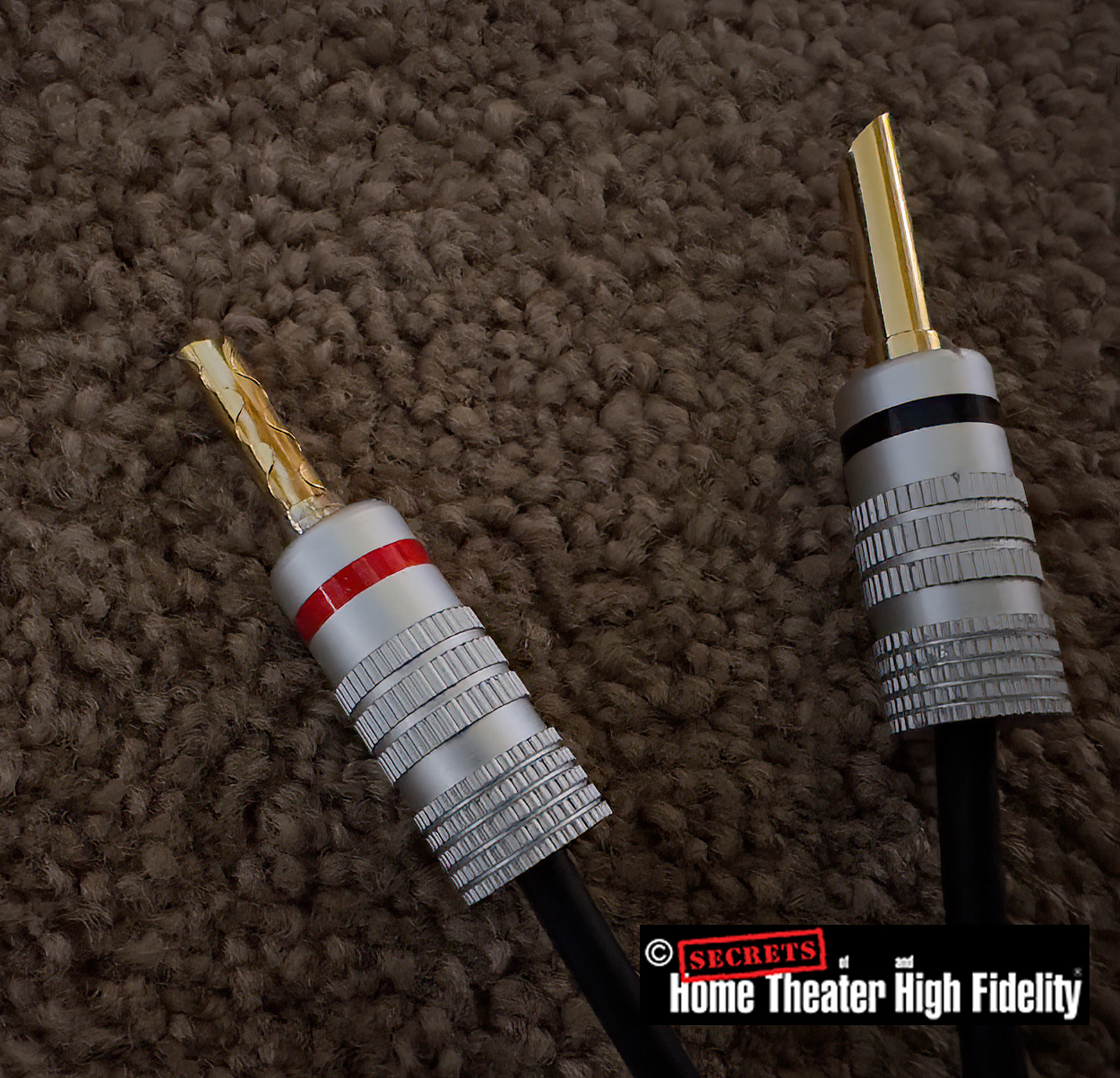
In this photo, you can see the North American standard banana plug. It simply won’t work on the Cyrus.

As noted, Cyrus will provide plugs for customers over here.
The Cyrus i9-XR does have a headphone jack, but it’s on the rear panel of the amplifier. That seems a poor design choice if your equipment is in a cabinet, making it a bit of a hassle to use.

Even if your Cyrus is out in the room on a shelf or credenza, plugging in headphones when you can’t easily see the jack seems like an unnecessary bother.
To make sure I was listening just to the integrated amplifier, I saved my listening tests with the Cyrus CD player for later. To audition the i9-XR, I attached my Bluesound streamer and also a Teac analog tape deck so I could hear the analog inputs.
This is one excellent piece of stereo electronics. I listened to CD-quality and high-resolution files through the digital inputs. I did try the various filters but found the differences small and hard to characterize. Still, I praise Cyrus for giving users the ability to tweak and compare. I used the default settings.
In general, I found acoustic music well balanced and pleasurable to listen to. I listened to several Vaughan William Symphonies because he was British, and this is a British component. Silly maybe, but I thought it was worthwhile. Williams’s work has extended dynamic range, some large-scale choral works to test imaging stability, and lovely string writing. I thought the sound of this amplifier was exemplary. I should note I listened using three speakers, some Ohm and Focal floor standers, and some KEF LS50s. All were easily driven by the i9-XR, and everything was quite musical.
I also listened to some acoustic jazz, and once again found excellent imaging and robust dynamic range.
Here are some details on my listening adventures using the Bluesound streamer for input and my Oppo BDP-203 CD player:

Vaughan Williams “A Sea Symphony”
Vaughan Williams Symphony #1. I auditioned the Leonard Slatkin CD. The Symphony features a wide dynamic range and a massed chorus, along with soloists. I got a solid image of the chorus and soloists. My impression is the dynamic range of this integrated amplifier is better than my normal systems at home by a wide, easily heard margin.
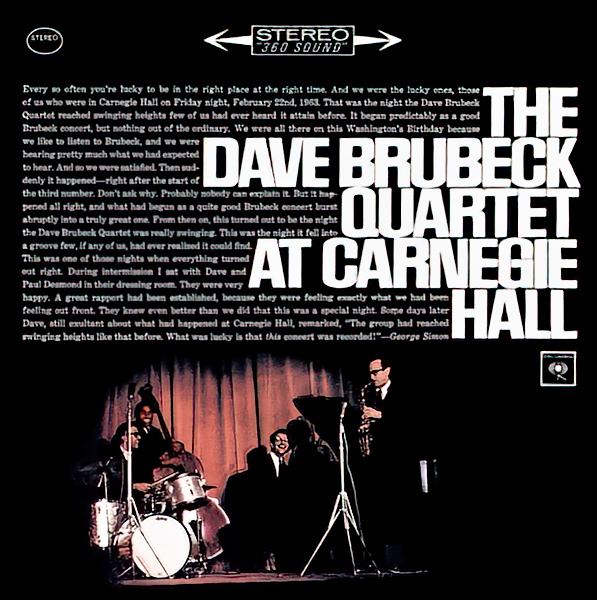
The Dave Brubeck Quartet “The Dave Brubeck Quartet at Carnegie Hall”
The Dave Brubeck Quartet at Carnegie Hall. A recording from 1963, that became a Columbia CD. I listened to a FLAC rip through the Bluesound. The “live” element is reproduced very well. The reverberation in the hall, the placement of the quartet, the “hits” on the percussion. This was from a period where Columbia produced some of the finest analog recordings, and it’s a nice transfer to the digital medium.

Rebecca Pidgeon “the Raven”
Rebecca Pidgeon – the Raven. This is my go-to music for listing to a female singer in an intimate acoustic space. Substandard equipment really constricts the sound. I listened to an 88.2/16bit FLAC file through the Bluesound streamer serving up content from my Roon system. It sounded live. The Cyrus demonstrated it was capable of first-class audio reproduction.

Soundtrack “Tron Legacy”
Tron Legacy: Another test of dynamic range with electronic instruments. This was a 44.1 kHz/24-bit file. My favorite track is Disc Wars for the bass and the wide frequency response in general. The Cyrus had no problems getting a clean sound to all the speakers I tested it with.

Soundtrack “How The West Was Won”
How the West Was Won. The venerable 1962 soundtrack from the Cinema Movie of the same name. I listened to this being played back from my Teac reel-to-reel deck. It’s an original recording on reel-to-reel and other than the expected tape hiss, it sounded just fine through the analog inputs on the i9-XR. The vinyl of this recording from MGM always sounded very compressed and grainy, but the reel-to-reel is very good, forgiving the pre-Dolby tape hiss.
The Cyrus i9-XR is not an inexpensive component. At $4,499.00 it’s going to compete with other high-end offerings. While I’m not familiar with everything being sold today that might be a competitor, I’m aware of and have heard similarly priced products. I think the i9-XR is fully competitive at its price, and even competes with some more expensive and esoteric components. Its very British styling might not appeal to everyone, and the Cyrus does not use standard speaker connectors, but that might be a small price to pay to get this level of performance. Having heard many separate pre-amps and amplifiers that come in at or about this price range, I believe the Cyrus offers at least comparable performance in a single integrated amp/preamp instead of separates.
- Exemplary sound.
- Superb build quality.
- Plenty of inputs both analog and digital.
- Customization options are plentiful.
- Enough power to drive most speakers.
- Less complicated remote operation, better iconography.
- Offer a version that works with speaker spade lugs or North American banana plugs.
- Add internet capability for streaming and updates.
- Display could be bigger and bolder. Hard to see across the room.
- Headphone jack on the rear panel is a poor choice for user convenience.
Heard without the other Cyrus components the i9-XR is an exemplary component. It has enough inputs to satisfy a digital or analog lover. It has low noise and seems to add or subtract nothing from good recordings. I’m not sure sound wise it can be meaningfully improved.
My next review in this series will be the Cyrus CDt-XR CD transport which will publish next week.


